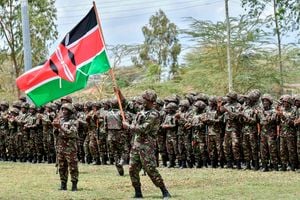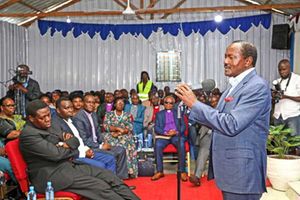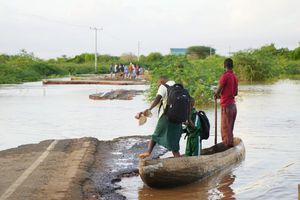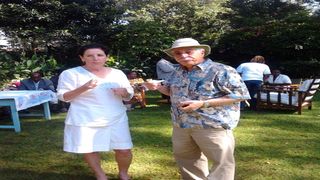
Dr David Silverstein and wife.
| PoolNews
Premium
David Silverstein: Why I chose Kenya over Israel and South Pacific
What you need to know:
- Israel appealed for its cultural and religious pull and because I spoke Hebrew. Then there was Kenya, suggested by Dr Ashvin Patel, who was to become a dear lifelong friend.
- I had applied for a teaching position at the University of Nairobi’s School of Medicine because I knew they were getting a cath lab.
This is part of a five-part serialisation of ‘Heartbeat: An American Cardiologist in Kenya’ by Dr David Silverstein
When my cardiology fellowship finished in June 1974, I had to figure out what came next. It was a question that most fellows, eager to launch their careers, had been addressing for at least a year.
I had procrastinated. The simplest option would have been to join a medical practice and become established as a cardiologist, maybe in Seattle where I had studied.
That choice offered professional and financial security as well as interesting medical challenges.
However, my Dad’s history of heart attacks shadowed my thinking and made me conflicted. I liked the prospect of a stable career where I worked my way to the top of my chosen profession.
I could serve my patients while satisfying a need to achieve excellence in everything I did.
On the other hand, it was the 1970s when everyone was discovering themselves. And my life might be short, I rationalized. The freewheeling spirit of the 1960s had ushered in an era of free love and political protest.
People my age were dropping out and getting high to Marvin Gaye and Bob Dylan. A part of me longed to be reckless and without responsibilities for a few years before settling down.
I discussed the situation with Charlie Clements. I think he saw in me, the footloose bachelor, a chance to live out his fantasies vicariously.
One evening he and I were on the back porch drinking gin martinis and reminiscing about the war. We were laughing a lot, trying to cap each other’s stories of bar girls we’d known and bullets we’d missed.
Late night traffic and the oboe croak of bullfrogs riffed in the background. It was a perfect night for sharing unguarded thoughts and wild dreams.
Suddenly Charlie stopped laughing. ‘You know David, coming home to a hot dinner and a warm bed every night is great but…’
He was staring straight ahead as if he could see something moving in the darkened trees on the other side of the fence.
Then he shook his head and scratched at something in his ear. ‘Sometimes I feel that I’m missing out on life, you know? There’s so much out there to find out about. Places and people that aren’t like us. Do you ever think that?’
‘You mean shedding all the stuff we grew up with and the plans I’d made for a regular, middleclass life? Are you talking about having adventures in places that are so far away we’ve never even heard of them? Yes, Charlie, I have.’
I pictured myself free as a bird, travelling the world with just a backpack. I wanted to make up for all those years in the shadow of my family before the early death I dreaded tripped me up.
It was a seductive fantasy but only that. The dream ignored a deep-rooted feature of my personality. I’m a workaholic, and I require a structure within which to function.
So with that important consideration in mind, I set out to achieve my version of youthful rebellion, creating a life and identity distinct from the family I loved and the man I admired most in the world.
This did not preclude expressing my hippy yearnings. I grew long hair and a beard and dressed the part as well. No coat and tie for this creature of the counterculture.
I had two requirements. I needed a cardiac catheterization laboratory to serve as my institutional affiliation to pursue what I believed was, and would continue to be, the most interesting work in cardiology.
After some consideration and conversations with friends, I narrowed my search to three possibilities. The University of the South Pacific was hiring. It sounded like a ticket to paradise.
Israel appealed for its cultural and religious pull and because I spoke Hebrew. Then there was Kenya, suggested by Dr Ashvin Patel, who was to become a dear lifelong friend.
He was a cardiology fellow at the University of Washington whom I had met while he was recovering from typhoid. Ashvin was a Kenyan of Indian descent from Nairobi. He had done his internship at Kenyatta National Hospital. He was familiar with the city’s medical establishment and described the professional opportunities in Nairobi in glowing terms.
I’d find the medical community so relaxed, he said, it would melt the cholesterol plaque in my arteries. I sent inquiries in all three directions.
When I was eleven my parents had taken me to see the movie South Pacific. It had made a great impression and fired my imagination.
On the way home, I’d exclaimed, ‘Wow, what if I move there and marry a beautiful girl from the islands?’ Mom had said, ‘That would be fine…as long as she’s Jewish.’ Dad had taken her seriously. ‘Sarah, don’t get carried away!’
But my childhood dream was not to be. The University of the South Pacific offered me deanships for its medical, dental and nursing schools and what was termed in the letter as ‘the mosquito school’. There was no mention of a cath lab.
They didn’t have one and didn’t plan on acquiring one any time soon.
Then there was Israel. I was a Hebrew speaker who knew the country well. I sympathized with the national imperative to safeguard the rebirth of an independent Jewish state.
I was invited to the Ben Gurion University at Be’er Sheva in the south Negev Desert. I flew over to inspect the facility and meet the chief of the department of medicine. If I would be interested, he said, I could be the second in charge of the coronary unit.
The university was only five years old. As yet there was no cardiac cath lab, but it was a future possibility. Be’er Sheva was not then the busy metropolis it has become, and the prospects for practicing the kind of cardiology I wanted to do were uncertain. I was tempted but in the end the deal breaker was the climate.
It was August and the heat was unbearable. I lay on my hotel bed at night sweltering next to an ineffective air conditioner as I pondered the pros and cons of living in a desert where temperatures reached 38º C and above.
The culprit was the khamsin, a gale force wind that blew for hours on end dumping sand it had brought from the Arabian Desert.
Khamsin is derived from the Hebrew word for fifty, chamishim, so called for the number of days it occurred each year. With some regret I crossed Israel off the list too. If you can’t stand the heat, get out of the kitchen.
That left Kenya. I had applied for a teaching position at the University of Nairobi’s School of Medicine because I knew they were getting a cath lab.
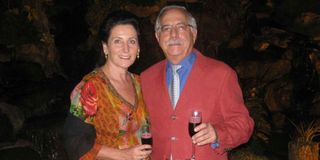
Dr David Silverstein and wife.
After six months of silence, I received a telegram followed by a letter informing me that a new cardiac cath lab was en route to Kenyatta National Hospital, the teaching hospital affiliated with the university.
Could I start immediately as a lecturer? This was roughly equivalent to an assistant professorship in the U.S. I would be under a two-year contract at Kenyan pounds 2500 a year (about $6200) and live rent-free in university housing.
I had heard about the Milbank Foundation which awarded grants to American educators in Africa. I applied and received an additional $5000 a year.
It was a welcome boost to my modest finances. This combined income was a fraction of what I might have earned elsewhere, but the excitement and challenge of living and working in Africa clinched the deal.
I was aware that nearly all African countries had once been colonies and had achieved independence during the previous two decades.
Otherwise I knew little about sub-Saharan Africa. I consulted an atlas, recalling from geography lessons it was on the west coast of the continent.
To my surprise, it was where it has always been – in East Africa facing the Indian Ocean.
It was a sad reflection on my primary school education. At that point Africa really was the ‘Dark Continent’ as far as I was concerned. My misconceptions were banished when, two months later, I stepped onto the cracked tarmac of Nairobi’s Embakasi Airport.
Nairobi was a fledgling metropolis with a population of less than a million. It was 1800 meters above sea level and lushly verdant.
Not far out of town lay the eastern escarpment of the Rift Valley with its breathtaking vistas of volcanoes and lakes shimmering in the heat haze.
The city was one degree south of the equator which meant the seasons were marked by the rains and the dry months rather than by winter and summer. Daybreak arrived at 6.30 am in the morning. Night fell like clockwork twelve hours later the year round.
The city was much quieter in those days. At the roundabouts uniformed policemen in white gloves conducted the traffic from raised podiums.
They looked as if they were calling on each section of the orchestra to perform. Some of the streets in the suburbs were unpaved. Many people walked or rode bicycles. You’d also see people driving donkey carts.
Volkswagens and Peugeots were popular as were Toyotas and Renaults. If they could afford it, most Kenyans travelled in public buses or privately operated minivan taxis known as matatus. Tatu was Swahili for three.
When matatus were introduced in the 1960s, the fare was thirty cents. Arriviste Kenyan businessmen and politicians favoured the Mercedes Benz. They were referred to, with a touch of envy, as wabenzi (the Mercedes Benz people).
Uhuru Highway was the town’s main artery delivering imported goods from the Indian Ocean port of Mombasa to Nairobi as well as people such as myself who had just flown in from abroad.
It was a memorable arrival. I have a vivid picture of being driven past a profusion of lilac-coloured jacaranda trees.
The highway was lined with them. The Hilton Hotel, which had only recently opened its doors, was one of the few buildings higher than three stories.
Kenyans’ almost universal civility was a mix of African deference and British good manners. The flip side of this proper behaviour were the night clubs and strip joints. I was introduced to them by Professor Ed Knight. He was West Indian and the only cardiothoracic surgeon in the country at the time.
Once a month he held Academic Night at the Sombrero, a popular and rowdy strip joint of note. These get-togethers provided an opportunity for the hospital’s senior clinical medical staff to let their hair down and get drunk while watching the show.
Nairobi National Park abutted the city. Its more than 100 square kilometres of grass plains and riverine forest contained all manner of wildlife including lion, leopard, cheetah, giraffe, Cape buffalo, zebra and different species of antelope.
During droughts the Maasai drove their cattle herds into town to graze the municipal grass on the roadside. The Europeans kept horses in the suburb of Karen. It had been named for the Danish author Karen Blixen who started a coffee farm there before World War I.
Her book Out of Africa evoked Kenya’s untrammelled spirit personified in her love affair with Denys Finch Hatton, a glamorous English aristocrat and professional hunter.
It was a staple for all new arrivals and had yet to be turned into the Hollywood blockbuster starring Robert Redford and Meryl Streep. Lions and leopards from time to time slipped into a suburban garden in search of a cow or dog.
You could drink from the municipal water supply without worrying about typhoid. There was an air of innocence and hope about the place with the edges blurred between past and future.
It would be years before the crime rate shot up, earning the city the sobriquet Nairobbery. Kenyans were not to be held solely responsible for this.
As civil war and unrest engulfed the neighbouring states of Uganda, Ethiopia, Somalia and Sudan, so small arms flowed across the border into Kenya.

Dr David Silverstain with his memoir ‘Heartbeat: An American Cardiologist in Kenya.’
Over the past two decades acts of terrorism have added to the insecurity. But in 1974 there was little violent crime. Petty theft, by contrast, was common.
Pole-fishers, as they were known, stuck long sticks through open windows in the hopes of retrieving a handbag or jewellery carelessly left on a table. If burglars were armed, it was with pangas (machetes).
In those days a sign on the gate reading Mbwa Kali Sana (Very Fierce Dog) was considered sufficient deterrent against intruders.
Kenya had gained independence ten years earlier following an uprising led by a movement called the Mau Mau. The ranks of the rebellion were drawn largely, but not solely, from among the Kikuyu, Meru and Embu people who lived on the well-watered massif of Mt. Kenya.
The British had encouraged European farmers to settle on this land during colonial times. When the British flag was lowered for the last time, it was feared there would be a bloodbath, triggered by African expectations to have their land returned. The anticipated chaos never happened. Kenyans were fortunate with their first leader.
Jomo Kenyatta was a man with an unusual breadth of vision who had studied at the London School of Economics in the 1930s. On taking over the helm of the nation, he shunned the Soviet bloc and aligned Kenya with NATO, Britain and the United States.
The mood in Nairobi was upbeat. Britain, the U.S., the World Bank and other Western donors drew up programs for development aid.
The flow of capital brought with it the promise of prosperity. The future looked bright, peopled with a generation of young Kenyans eager to be trained in all sectors of the economy and essential services including, of course, the medical world.
In the last fifty years there has been significant progress, particularly in the health sector. Medical diagnosis and treatment in both the public and private sectors have greatly improved.
Kenyans now have better medical care and live longer than they did during colonial times. I am proud to have played a part in making this happen.
However, when I first arrived in Kenya my concerns were more immediate. I wanted to see the new cath lab that I would be running.
Kenya had never had a cath lab. Neither had there been a fully trained cardiologist until I came along.
Tomorrow in the Sunday Nation: Kenya’s secret role in the 1976 Entebbe raid that only President Jomo Kenyatta and three other people knew about. Also, romance in a time of terror



